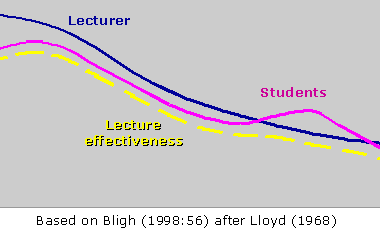Contents
Lecture: "The process by which the notes of the lecturer become the notes of the student without passing through the mind of either"
The lecture is still the standard teaching event in higher education—although nowhere else—and thus an illustration of Atherton's law, "The amount of attention paid to teaching and learning is in inverse proportion to the perceived ability of the students."
For once, there is a standard text in the field. Bligh (6th edn. 2000) may tell you more than you ever wanted to know, but it is very clear and well laid out for skimming by busy academics. It includes 23 pages of references, in double columns and 8-point text: admittedly, some of them relate to dubious research on the memorisation of nonsense syllables, but he has covered all the angles.
These notes are unduly dogmatic, but read Bligh for background.
You may have found lectures boring at university, but consider what they are like for today's students: when did they (or you) last listen to anything almost uninterruptedly for an hour, with little else going on?
Blow all the stuff about "learning styles"; the lecture is basically the social technology of the Middle Ages. Only if you appreciate the greatest radio station in the world (BBC Radio 4) is there nowadays any chance that you are used to taking in information by sheer listening for an extended period—and even there, there will be many voices. In a world of sound-bites and visual technologies it requires skill to listen this way—and it is a skill students do not naturally acquire at school or at home.
Use
Lectures are relatively effective for conveying information, but—unsurprisingly—not for developing skills or changing attitudes. Used in conjunction with other methods, such as set reading, seminars and student presentations, they can provide a useful overview of a field and help students to make sense of their other work.
Attending a lecture is a passive experience for the student. Of all teaching events, the lecture is most likely to promote basic assumption dependence and sleep. Note-taking is up to the students, their level of motivation and their skill, so—
Signposting
It is useful—nay, vital—to enable the students to appreciate the shape of the argument. The biggest single problem with note-taking is not appreciating the level of the point which is being made. Lectures unfold over time, and students do not always know whether what they are listening to is a major substantive point, its elaboration, or a gloss or even digression. You can signpost aurally—"The next major issue to consider is ..." —but an outline presented visually and returned to at appropriate points is much more effective. A gapped handout serves much the same purpose.
Further to the listening point above, listening for 50 minutes (assuming it is possible) requires attention at several levels, principally not only to the detail of the current point, but also to its place within a developing argument.
Attention
Bligh's evidence suggests a fairly steady decline in student attention (and lecturer performance) from the start to the end of a traditional one-hour (50 minute) lecture. Students blip upwards about 10-15 minutes before the end, but this has little effect if the lecturer continues to go downhill. He suggests that the limit to students' effective attention is 25-30 minutes. I think that may be optimistic, and in any case there is no point in going up to the wire.

Attention span in lectures
(claimed—it is not clear what constitutes the y axis scale)
The good news is that even half a minute's respite has beneficial effects, and that a change is almost as good as a rest. So
- inviting questions
- posing a simple multiple-choice question, answered by a show of hands
- setting a simple exercise for buzz groups
or anything else which varies the pace may produce the desired result.

Notional effect of interruptions on attention
↑ TopRehearsal
A relatively rapid rehearsal of the content can make a considerable difference to retention. A seminar or lab session immediately following the lecture is perhaps the best way to achieve this —and "Any questions?" with two minutes to go, probably the worst (apart from not inviting any questions at all).
Posing a question for the students (or providing an example sheet to be worked through before the next session) should leave them thinking—but it is important that this is not merely an empty exercise and that it is given value at the start of the next lecture (even if it is only the "swots" who address it).
Further reading
For very practical advice, see:
- GIBBS G (1992) 53 Interesting Things to Do in Your Lectures Oxford; Technical and Educational Services
- BROWN S and RACE P (2002) Lecturing: A Practical Guide London; RoutledgeFalmer
- RACE P (ed.) (1999) 2000 Tips for Lecturers London; RoutledgeFalmer
- RACE P and BROWN S (2001) The Lecturer's Toolkit: A Practical Guide to Learning, Teaching and Assessment London; RoutledgeFalmer
- and—with particular reference to Further Education and hence not so much to lecturing—Geoff Petty's site at http://www.geoffpetty.com/
This is an archived copy of Atherton J S (2013) Learning and Teaching [On-line: UK] Original material by James Atherton: last up-dated overall 10 February 2013

This work is licensed under a Creative Commons Attribution-Noncommercial-No Derivative Works 3.0 Unported License.
"This site is independent and self-funded, although the contribution of the Higher Education Academy to its development via the award of a National Teaching Fellowship, in 2004 has been greatly appreciated."

